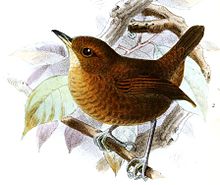
The buff-throated woodcreeper is a resident passerine bird found in tropical South America in the Guiana Shield and disjunctly in the northern Atlantic Forest. It formerly included the cocoa woodcreeper and the Lafresnaye's woodcreeper as subspecies. Some authorities retain Lafresnaye's position as a subspecies of the buff-throated woodcreeper, but the resulting group is polyphyletic.

The buff-fronted owl is a small owl. It is found in widely separated areas in every South American country except French Guiana and Suriname.

The musician wren or organ wren is a species of wren named for its elaborate song. It is native to the Amazon rainforest in South America, from the lowlands into the foothills of the Andes.

The white-throated screech owl is a small owl found in the Andes of Bolivia, Colombia, Ecuador, Peru and Venezuela.
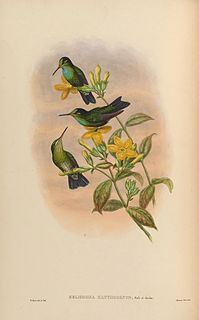
The velvet-browed brilliant is a species of hummingbird in the "brilliants", tribe Heliantheini in subfamily Lesbiinae. It is found in Brazil, Guyana, Suriname, and Venezuela.

The peacock coquette is a species of hummingbird in the "coquettes", tribe Lesbiini of subfamily Lesbiinae. It is found in Brazil, Guyana, and Venezuela.
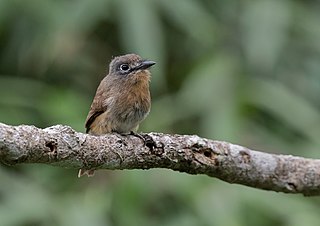
The rusty-breasted nunlet is a species of near-passerine bird in the family Bucconidae, the puffbirds, nunlets, and nunbirds. It is found in Argentina, Brazil, Colombia, Ecuador, Guyana, Paraguay, Peru, Suriname, Venezuela, and possibly French Guiana.

The white-headed wren is a species of bird in the family Troglodytidae. It is found in Colombia and Panama.

The bicolored wren is a species of bird in the family Troglodytidae. It is found in Colombia, Venezuela, Guyana, and Brazil.

The smoke-colored pewee is a species of bird in the family Tyrannidae. The species is characterized by a uniform dusky-grey plumage.

The grey-breasted wood wren is a species of bird in the family Troglodytidae. It is found from Mexico to Bolivia.
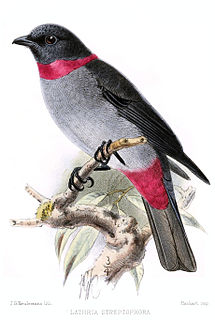
The rose-collared piha is a species of bird in the family Cotingidae. It is found in humid forests growing in the tepui highlands in south-eastern Venezuela, western Guyana and far northern Brazil. Only the male has the rosy collar for which this species is named. The female resembles the screaming piha, but has a cinnamon vent.
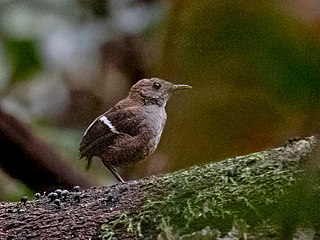
The wing-banded wren is a species of bird in the family Troglodytidae. It is found in Brazil, Ecuador, French Guiana, Guyana, Peru, Suriname, and Venezuela.

The southern nightingale-wren, also known as the scaly-breasted wren, is a species of bird in the family Troglodytidae. It is found in Bolivia, Brazil, Colombia, Costa Rica, Ecuador, Panama, Peru, and Venezuela.

The olive-backed tanager is a species of bird in the family Mitrospingidae. It is found in Brazil, Guyana, and Venezuela.
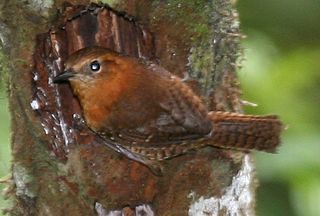
The rufous-browed wren is a species of bird in the family Troglodytidae. It is found in Central America from Mexico south into Nicaragua.

The tepui wren is a species of bird in the family Troglodytidae. It is found in Brazil, Guyana, and Venezuela, where it inhabits high tablelands called tepuis.

The mountain wren is a species of bird in the family Troglodytidae. It is found in the Andes of northwestern Argentina, Bolivia, Colombia, Ecuador, Peru, and western Venezuela.
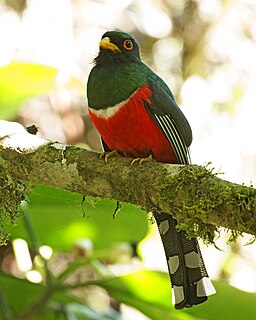
The masked trogon is a species of bird in the family Trogonidae. It is fairly common in humid highland forests in South America, mainly the Andes and tepuis.

The tepui toucanet or Whitely's toucanet is a South American species of bird in the family Ramphastidae. It is native to the humid forests of the tepuis and other highlands of the Guiana Shield. It was formerly considered conspecific with the chestnut-tipped toucanet.
